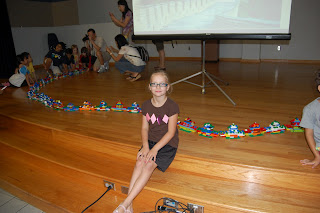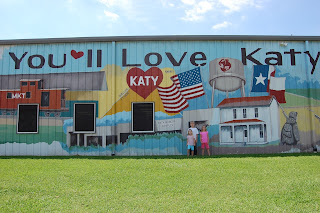We have been looking for a way to store our canned food that takes up less space than just putting them on a shelf. We found inspiration on Pinterest and built our own self-rotating racks! With just a piece of plywood and some 1x3s and some 1x2s. Some L brackets and lots of screws we built this!! We made sure that the cans that we wanted to put here fit in each row. At the bottom of each row, we put this wedge piece.
And on the wedge we screwed in an L bracket. That way the can doesn't fall out on it's own.
We screwed two boards with an angled cut at the top to the wall and the rack had boards with opposite angle cuts on the back.
Here is the first rack. The end spot was not big enough for a can, so Toby just put two shelves and we are stacking tuna there!
And here are both! I love them!!!
UPDATE
We had a request for more information on the canned food rack that we posted a couple of months ago. Since it's hanging on the wall, it's kind of hard to get pictures, so I'll try to explain what I did.
If I was building it again, I'd use very thin plywood (1/4" or thinner) for the pieces that go on the front of the rack, instead of 1"x2". They just have to be strong enough to prevent the cans from falling forward and using thinner wood would make it lighter.
The angled piece at the bottom of each row of cans was just cut from a
2x4. My saw blade wasn't
quite large enough to cut all the way to the top of a 2x4 so I cut off about 1/2" from the top of the 2x4, see Fig 1.
Then I cut the 2x4 lengthwise in half at an angle. I angled my saw
blade at around 25 deg to cut through the bottom corner and angle up to
come out at the opposite top corner see Fig 2.
Once I had it cut in half at an angle, I cut the piece into 2-3" wide triangles. These are what I attached to the bottom of each row of cans. I glued and then drilled a countersunk hole in the angled pieces at the bottom of where the cans will go. I then put a screw in the countersunk hole and made sure the head didn't come above the surface of the wood. That gave me a sturdy and secure surface to attach the angle bracket.
The boards that hold it to the wall were about 1/2" thick plywood. I cut them into strips about 6" wide. Then, I made a 45deg cut lengthwise down the center of the strip, producing 2 3" wide pieces. I then repeated until I had 4 3" pieces for each rack. I marked the two halves so I knew which pieces went together, in case there was any variation in the 45deg cut. Find the studs in your wall and mark them. While you could use drywall anchors I think screwing the boards to the studs is much more secure. You attach two separate piece to the wall, with the cut side pointing upward and the high side of the 45deg cut away from the wall. This creates a pocket against the wall. If you attach it backward, the cut will slope away from the wall and the food storage rack will fall off. I then set the other two pieces into their matching pieces on the wall. With a second person, we then held the rack up against the 4 boards on the wall. Quickly drive 2 screws through the rack into each of the unattached pieces. This will connect them to the rack and make sure they match up with the 2 pieces on the wall. I then screwed screws through the rack into both the rack mounted board and the wall mounted board to give it more strength and prevent it from moving.


.JPG)




.JPG)

















.JPG)
















